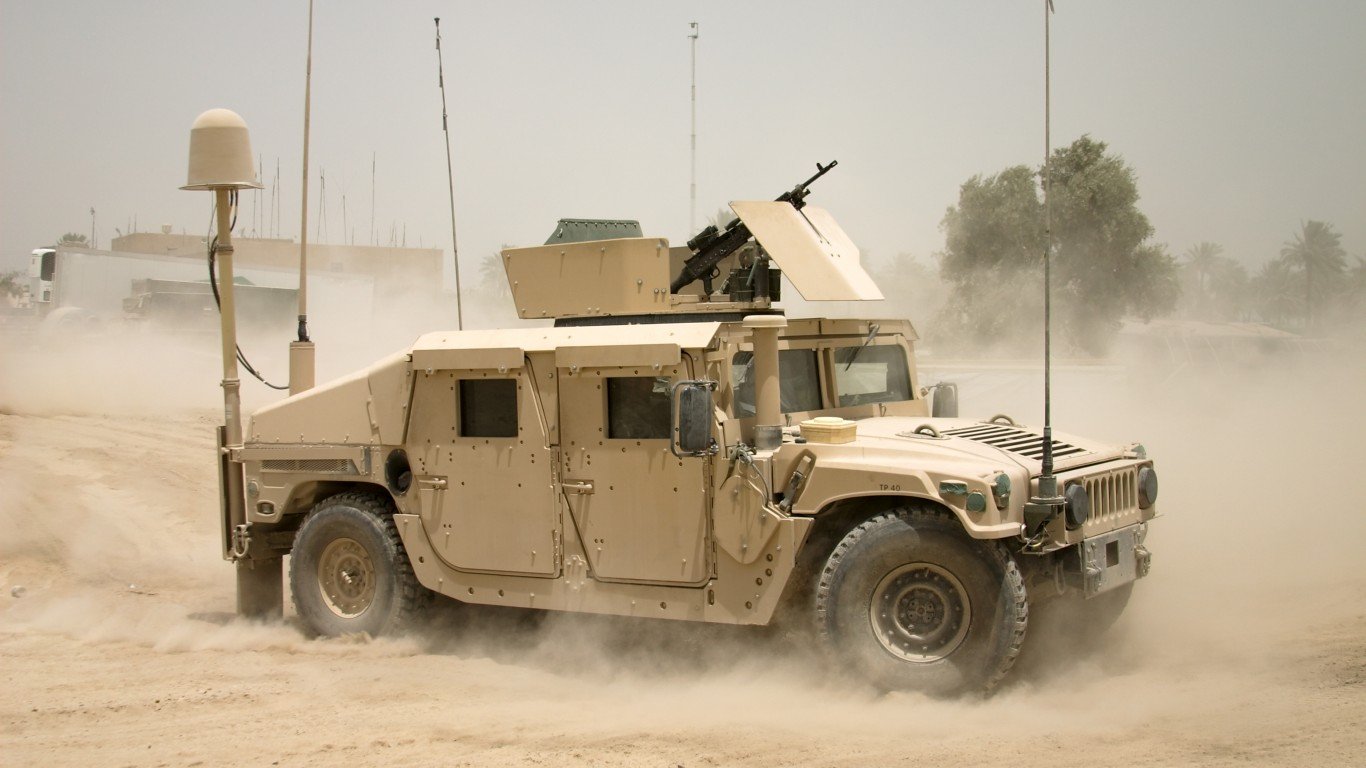Special Report
Since their inception, tanks have always been a vital part of a military’s army. Often considered the ultimate battlefield weapon, these deadly, powerful weapons allow armies to rapidly advance during war and are still a major component of ground combat. These revolutionary army vehicles are often crucial to operations, as evidenced in the ongoing Ukraine War. As the war in Ukraine drags on well into its second year, Russian losses continue. One think tank estimates that more than 40% of the country’s prewar fleet of tanks have been lost.
For the past century, every war fought has heavily relied on vehicles for combat, supplies, movement, and much more. Advancements in military vehicle technology may have turned the tide of some of the largest conflicts in history. Russia is no exception. These vehicles are crucial to Russian operations, and each one lost represents a significant financial and tactical setback.
24/7 Wall St. reviewed land-based vehicles that had a major impact on the technology and outcome of warfare using information from Military.com, The Imperial War Museum, The National WWII Museum, and more to determine the most important vehicles in the history of war. Many of these vehicles were invented to serve a specific purpose. Some were able to quickly get messages to strategic points on the front lines. Others were designed to move troops while shielding them from enemy fire.
World War I broke out shortly after automobiles became commonplace, and military leaders quickly realized the impact these vehicles could have on the battlefield. It wasn’t long before engineers worked on ways to produce armed and armored vehicles that would protect troops as well as have some attacking capabilities while on the go. (This is the largest tank battle in history.)
These machines continued to advance with technology. World militaries produced vehicles with thicker armor, faster speeds, more rugged capabilities, and more firepower than ever before. Some of these advancements proved to have significant civilian applications as well. These are the popular products you never knew were invented by the military.
Here are revolutionary army vehicles that transformed warfare
1. Mark I Tank
Source: Topical Press Agency / Hulton Archive via Getty Images
- Introduced in: World War I
World War I trenches made it nearly impossible for troops to advance, as both sides had their weapons ready if anyone peered over the fortifications. The British Navy devised in 1915 a new type of armored vehicle that rolled on a continuous track. Communications referred to these vehicles as “tanks,” like water tanks, to ensure their secrecy. By 1916, British soldiers rolled the Mark I Tank into battle. Early models were unreliable, but by 1918, there were over 2,500 used in the war.
2. Renault FT light tank
Source: Three Lions / Hulton Archive via Getty Images
- Introduced in: World War I
The British may have invented the earliest version of the tank, but it was the French who made their own version early on in World War I – except the French tank had significant attacking capabilities as well. The Renault FT light tank was the first tank to include the key addition of a 360° rotating turret, which has since become a standard feature in virtually every tank. More than 3,000 were used in World War I.
3. Rolls-Royce Armoured Car
Source: Hulton Archive / Hulton Archive via Getty Images
- Introduced in: World War I
The very first Rolls-Royce Armoured Car was reportedly cobbled together in 1914. Ordered to help spot enemy troop movements, a Royal Naval Air Service squadron based in Ostend, Belgium, equipped a Rolls-Royce with a machine gun and boilerplates as armor. The vehicle proved to be so vital that more were ordered for battle. Though they were not suited for the trenches, Rolls-Royce ACs proved to be incredibly important in other types of fighting.
4. Liberty Trucks
Source: Public Domain / Wikimedia Commons
- Introduced in: World War I
First developed for World War I, Liberty Trucks were large 5-ton transport units. They are significant in the history of warfare because they were the U.S. military’s first-ever standardized vehicle, meaning dozens of different factories produced parts, and 15 companies were all able to assemble identical trucks, streamlining the production and maintenance processes.
5. Harley-Davidson WLA
Source: Bukvoed / Wikimedia Commons
- Introduced in: World War II
The most-produced military vehicle of all time was the Harley-Davidson WLA with over 90,000 motorcycles produced beginning in 1940. The bikes were created for quick maneuvering through all types of terrains, including North African deserts and European forests. Motorcycle couriers became one of the main communication lines in the war. The WLAs were often equipped with sidecars to quickly drive officers around. Machine guns were sometimes attached to the WLAs as well.
6. Willys Jeep
Source: Public Domain / Wikimedia Commons
- Introduced in: World War II
The Willys MB was a tough, efficient 4×4 vehicle that is now better known as the first incarnation of the Jeep. U.S. Army chief of staff during World War II, Gen. George C. Marshall, called the vehicle “America’s greatest contribution to modern warfare.” The Jeep proved remarkably useful as a vehicle for combat, patrol, transit, ambulance duty, and much more. Its utility helped phase out the use of motorcycles and horses in warfare.
7. M4 Sherman Tank
Source: lodekka / Flickr
- Introduced in: World War II
American production lines saw more M4 Sherman Tanks manufactured than any other tank in history – nearly 50,000 in total. Though it did not have the same quality of armor and guns that many other tanks of the era had, its main advantage was its simple design. This allowed multiple car manufacturers to mass-produce the M4 Sherman, giving U.S. troops a numbers advantage over the German Panzers.
8. GMC DUKW
Source: Public Domain / Wikimedia Commons
- Introduced in: World War II
Known as “The Duck,” the GMC DUKW was a partially-amphibious vehicle used in World War II. The U.S. Army needed a way to quickly traverse land and rivers across Europe as bridges were often destroyed. Enter the DUKW, a GMC 6×6 that was adapted to fit a customized boat hull. The vehicle allowed soldiers to cross land and water more efficiently than ever before.
9. Dodge WC-54 Ambulance
Source: rutgervandermaar / Flickr
- Introduced in: World War II
The Dodge WC-54 Ambulance served as the main medical transport vehicle for the U.S. throughout World War II. The large trucks had room for six seated patients or four stretchers. Even after World War II, some WC-54s remained in service – the U.S. used a handful during the Korean War, and other European countries used them into the 1960s.
10. White M-3 Half-Track
Source: Public Domain / Wikimedia Commons
- Introduced in: World War II
The White M-3 Half-Track was used as an armored personnel carrier throughout World War II. The boxy vehicle was covered in armor plating and featured wheels on the front but a tank-like track on the back. This unique design allowed the half-tracks to push through all kinds of muddy or rocky terrain. They were also armed with machine guns, used to support assaults on enemy positions.
11. LVT4 Landing Vehicle
Source: Public Domain / Wikimedia Commons
- Introduced in: World War II
The LVT4 landing vehicle was so called because it was needed to help American troops land on islands held by Japan throughout the Pacific Theater of World War II. Initially known as Alligators, these vehicles were designed to power over sharp reefs around the islands, while their heavily armored body protected troops from incoming fire. A ramp in the rear provided a safer way to exit while under fire.
12. Volkswagen Type 82 Kübelwagen
Source: falcon_33 / Flickr
- Introduced in: World War II
Although the U.S. and its allies made important and impactful vehicles during World War II, they weren’t the only ones. Germany produced the Volkswagen Type 82 Kübelwagen – a 4×4 created to be resistant to all different types of weather like mud and snow. Its configuration also made it less susceptible to gunfire, while also featuring an auxiliary fuel tank to keep it running even in the cold of the Russian winter.
13. T-34
Source: camperdown / Flickr
- Introduced in: World War II
The Soviet T-34 is one of the most important vehicles in the history of war because its capability and firepower made it the most fearsome vehicle of the WWII era. It featured a 76.2 mm gun that could take out other tanks, while its armor could survive direct hits from existing anti-tank weapons. When the Germans advanced towards the Soviet Union, these tanks were key in repelling the German Army from the Eastern Front.
14. Bradley Fighting Vehicle
Source: Scott Nelson / Getty Images News via Getty Images
Designed to battle over long distances, the Bradley Fighting Vehicle is unique for its combination of durability and firepower. The BFV was first rolled out during the 1980s and saw its first action in the First Gulf War. It was later used in Iraq and Afghanistan. Though intended as an infantry fighting vehicle, the Bradley features both medium and long-range weapons with enough firepower to take on tanks.
15. Humvee
Source: specnaz-s / iStock / Getty Images Plus
High Mobility Multipurpose Wheeled Vehicles, nicknamed “Humvee,” were used by the U.S. military beginning in 1989 in the invasion of Panama and later the Gulf War. The Humvee is designed to cover all kinds of terrain while shielding passengers from all manner of attacks – all while requiring minimal repairs. The Humvee, like the Jeep before it, went from a military vehicle to a civilian vehicle in 1992, when General Motors rolled out the Hummer.
16. Cougar 6×6 MRAP
Source: Public Domain / Wikimedia Commons
- Introduced in: Wars in Afghanistan and Iraq
Improvised explosive devices were killing and injuring soldiers during the War on Terror in Afghanistan and Iraq. To deal with the threat of IEDs, General Dynamics devised the Cougar 6×6 MRAP, which stands for Mine Resistant Ambush Protected. The vehicle can withstand ballistic and explosive attacks, with room for up to 10 passengers.
Sponsored: Attention Savvy Investors: Speak to 3 Financial Experts – FREE
Ever wanted an extra set of eyes on an investment you’re considering? Now you can speak with up to 3 financial experts in your area for FREE. By simply clicking here you can begin to match with financial professionals who can help guide you through the financial decisions you’re making. And the best part? The first conversation with them is free.
Click here to match with up to 3 financial pros who would be excited to help you make financial decisions.
Thank you for reading! Have some feedback for us?
Contact the 24/7 Wall St. editorial team.




